Here, we will introduce some references on canine communication, for you to start with. For more information, you can read this review article. It is important to note, that canine body language, has much to do with communication signals, needed to reduce conflict and is directly related to their culture of dominant and submissive relationships.
The chart below is great for showing the relationship between fearful or submissive facial expressions along with dominant or assertive facial expressions and varying degrees of aggression.
In general, the more confident a dog is in a situation, the facial muscles will pull forward. So lips, ears, and brow will all be pulled toward the front. This can be done in a way that shows a more confident state of mind without expressing any aggression, or it can remain pulled forward while exhibiting varying degrees of aggression.
The lesser confident or submissive dog tends to pull everything on the face backwards: ears, lips, and brow. When the dog does start to show aggression, we will actually see more teeth because of this.
Keep in mind that the confidence level, expression, and even aggressive response of the dog is largely emotional and isn't something the dog necessarily decides to do. These are mostly a reflection of how confident the dog feels and how threatened a dog feels. A dog will use these expressions when interacting with another dog or person and when protecting itself or something the dog feels is important such as food or even social status.
Higher on the chart represents less confidence, and toward the right represents more threatened. A dog can be confident and still feel another is a threat to something important.
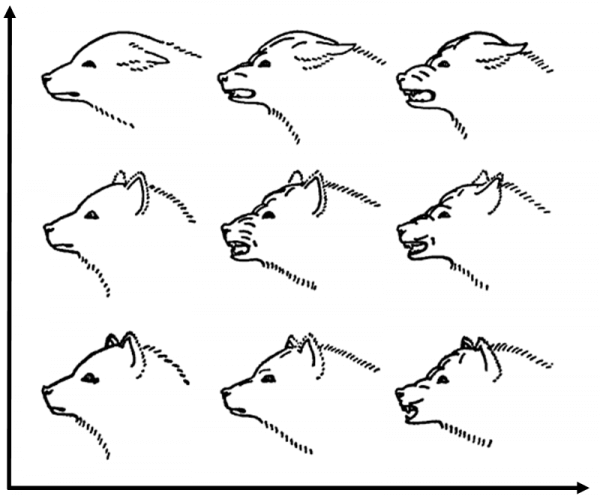
The body of the dog also tends to reflect what is going on in the face. So a dog that is feeling confident, also has its center of gravity leaning forward and tail pulled up and forward. A less confident dog will usually have its center of gravity leaning backward and tail pulled backward and under. Obviously, there will be varying degrees between these two extremes with both the face and the body.
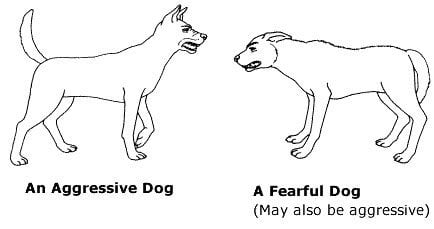
Some of the most subtle and overlooked signals that dogs give each other are commonly known as "calming signals" in the dog training industry. This term was coined by a Norwegian dog trainer, Turid Rugaas, and has been universally accepted by the dog training community to refer to behaviors, that are designed to diffuse social tension or "calm" a situation.
Here are some of the most common calming signals:
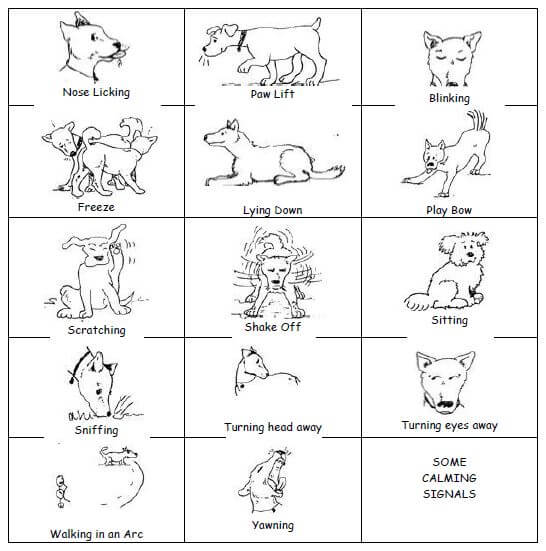
Tongue flicks:
Tongue flicks are a very common calming signal. Sometimes it can be nothing more than a very quick lick, with the tip of the tongue barely visible outside the mouth, and only for a short second. Other times, the tongue can curl up to touch the nose. There can be multiple flicks if the tension is not reduced. It is a non-aggressive way to signal a desire for peace and to reduce tension if another dog (or person) is focused on their face.
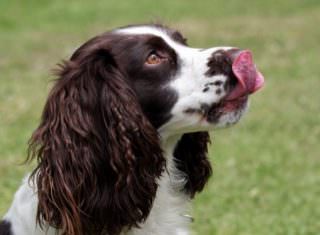
Blinking:
Blinking is used by dogs when there is eye contact with another dog or person, but that dog wants to make it clear it is not meant as a challenge. Blinking can vary between one slow blink, multiple blinks, or squinting, depending on how much tension is perceived by the dog. Consider the fact that, whereas a wide-eyed and intense stare, is considered a direct and dominant challenge, these blinking and squinting behaviors are the polar opposite.
Sniffing the ground:
Sniffing the ground may look anything like moving the nose swiftly down toward the ground and back up again, to sticking the nose to the ground and sniffing persistently for several minutes. Although dogs often do sniff the ground for many reasons, in some cases this seems to be a way for a dog to appear as if they are preoccupied with a common activity, and is used to avoid a potentially stressful interaction. This gives another dog zero feedback about social status or intentions, concerning the interaction. Sniffing the ground is similar to a person pretending to be interested in their cell phone, while walking by a person or group, who may otherwise try to make eye contact or interact with them.
Scratching:
Very similar to sniffing the ground. It is used by some dogs to avoid a potentially stressful interaction.
Looking away:
The dog can turn his head slightly to one side, turn the head completely over to the side, or turn completely around so that the back and tail is facing whoever is focused on the dog. Dogs will do this to defer from challenges and also to signal a desire to avoid interaction. This is not to be automatically associated with submissive behavior, since a dog may look away to avoid requests for just about any type of activity ranging from play to a social challenge. The full context of the rest of the body language needs to be considered.
Play bow:
Going down with front legs in a bowing position can be an invitation to play if the dog is moving legs from side to side in a playful manner. Just as often, the dog is standing still while bowing and is using the signal to calm someone down. These signals often have double meanings and may be used in many different ways – often the invitation to play is a calming signal by itself because the dog is making a potentially dangerous situation less tense and diverting attention to something safe (play).
When two dogs approach each other too abruptly, you will often see a play bow. This is one of the signals that is easy to see, especially because they remain standing in the bow position for a few seconds.
Play face:
The play face is a relaxed facial expression with a relaxed open jaw. Since dog play consists of "practice fighting" and "practice hunting," the play face helps give an obvious signal during play, that all the chasing and physical contact is non-aggressive in nature and all in good fun.
Paw lifting:
Dogs can lift their paws in assertive ways to poke at other dogs to solicit play or other interaction, but when lifted slightly and paired with other submissive or fearful postures, it is a pacifying posture, which can escalate to the dog rolling over and showing his underside.
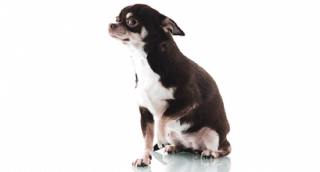
Walking slowly:
High speed can be upsetting to many dogs, and they might want to go in to try and stop the one who is running. This is partly a hunting behavior and is triggered by the sight of a running human or dog. The running can also be viewed as a threat if it is moving directly toward another dog or person. Therefore, walking slowly is done by some dogs during initial interaction. Dogs that are not good at this and "rush" into new interactions are often corrected by other dogs accordingly.
Freezing:
"Freezing" is when the dog stops abruptly and remains completely still, often looking out of the corner of his eye when no longer moving the head. Freezing is often accompanied by "walking slowly" and is done when dogs are carefully calculating their next move with another dog to avoid conflict. Although freezing is associated with calming signals, it must be noted that freezing may also happen just before a dog exhibits aggressive behavior. The rest of the dog's body language and vocalizations need to also be considered. Either way, in these cases the "freezing" of the dog gives another dog or person the ability to read the rest of the language and diffuse escalation before aggression occurs.
Sitting down:
To sit down, or an even stronger signal, to sit down with the back turned towards someone – for instance the owner – has a very calming effect. It is often seen when one dog wants to calm another dog who is approaching too quickly. Dogs may sit down with their backs turned against the owner when he or she sounds too strict or angry. Sitting is also a common position an adult dog will take when interacting with a puppy, as it tends to have a non-threatening appearance.
Walking in a curve:
This signal is frequently used as a calming signal, and it is the main reason why dogs may react so strongly to meeting dogs, when they are forced to approach head on. Their instincts tell them that it is wrong to approach someone like that. Forcing dogs to approach each other head on can cause them to feel anxious and defensive, and can eventually result in aggressive behavior like barking and lunging at other dogs. Dogs, when given a chance, will walk in curves around each other. This is what they do when they meet off leash and are free to do things their own way. It is also commonly observed when training a dog to come when called. You may notice that a dog will approach in a curve during the early training or when they are unsure of the recall exercise.
Yawning:
Apart from yawning when tired or bored during inactivity, dogs will yawn during interaction as an indication of stress. It is very common during obedience sessions that are too fast paced or too stressful for the dog. It can be interpreted as a dog needing a break or feeling overwhelmed. It is considered a pacifying behavior.
Submissive Smiling:
This is generally an extreme display of submission, although it can be misinterpreted as aggressive toward someone, who is not reading the rest of the dog's body language.
Watch the video below to watch a dog's submissive smile and sneeze which is also a type of calming signal, meant to pacify a situation.
Frolicking:
Some dogs act like puppies, jumping around, being silly, throwing sticks around etc, if they observe a fearful dog nearby. This is intended to have a calming effect.
Lying down (with belly on floor):
This is a type of "time out" from interaction, such as during rough play. Sometimes, unsure dogs will go into this position as another dog or person approaches, until they decide how they will interact. It is also related to hunting behavior, where a dog may crouch to be inconspicuous before pouncing.
Shake off:
A shake off seems to indicate a desired "end" to an interaction, as if to say they want to disconnect and do their own thing for the time being. It can simply be used to request an end to play, diffuse a social conflict, or to end any other interaction.
Another "shake-off":
Watch shake-off with a doberman and wolf:
Splitting:
This is easy to observe when multiple dogs are interacting with each other. When tensions rise a bit between two dogs, a third dog might try to put his body between the two dogs. Dogs will also do this with people, if they perceive tensions rising.
Whale eye:
This one can be misinterpreted, since there are many different reasons why dogs will move their eyes in a way, that exposes the whites of their eyes. Sometimes, dogs are simply scanning the environment and because of their natural position (such as when relaxing on the ground), they may move just their eyes instead of their whole head.
There are two types of whale eye to look out for that are both indicative of stress:
One, is when the dog cannot easily turn his head away from a situation that he feels uncomfortable about, so instead, the dog diverts his eyes away from the situation. It can be interpreted similarly to a head turn, except the dog is usually more stressed, because of an inability to easily physically distance himself from the interaction.
The second, is where the dog's head is pointed away from another person or dog, but the eyes are focused toward the person or dog. In these cases the dog is indicating, that he would like space, in a more assertive way. This is common with resource guarding. A dog may have his mouth focused on food or an object, but his eyes are focused on a dog or person. This type of whale eye accompany other body language, such as freezing and growling, but it is in this case specifically communicating to give space. This can escalate into aggression if not recognized or directly challenged.
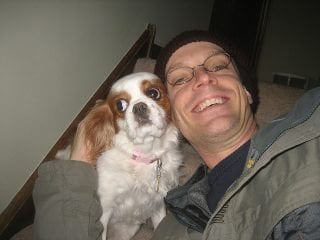

Can you spot the whale eye, freeze, sitting, shake off, and sniffing in this video?
Other behaviors to note are:
Humping:
Humping is generally a demanding way to solicit activity or attention. It can be confusing since it is obviously the same motion used when mating, but males and females alike, will "hump" to get attention during play and to even demand play or affection from a human.
Depending on the rest of the body language, such as a lack of a "play face", a dog mounting a person or another dog can be more serious in nature and indicate a demand for submission. This can escalate into aggression from either the humper or humpee.
During times of mating, a dog may also mount a female to "claim her" when near other rivals although there is likely to be no "humping" movement.
T'ing off:
This is when a canine will put there head over the shoulders of another to make a clear statement of a dominant position. Here is a video of it with captive wolves. I assume a lot of this behavior is going on in this captive pack. It is obviously a bad situation with many adult wolves lacking a clear desire to submit to the "alpha" in this case. You can see what t'ing over another canine is and that it is performed by both wild and domestic canines:
Here is a lecture by Stanley Coren, who has written much on the subject of canine body language. This a pretty good lecture, that goes a little off track with a couple of debatable interpretations, but is still very useful to watch. There is always much left to our interpretation.
Here are some definitions of canine vocalizations that are also largely based off Stanley Coren's publications:
Barks:
Barking in rapid strings of 3 or 4 with pauses in between, mid-range pitch: alert call - the dog senses something but not yet defined as a threat.
Rapid barking, mid-range pitch: basic alarm bark.
Barking still continuously but a bit slower and lower pitch: imminent threat, prepare to defend.
A prolonged string of barks, with moderate to long intervals between each one: lonely, in need of companionship, often exhibited when confined.
One or two sharp, short barks of high or mid-range pitch: typical greeting sound, usually replaces the alarm bark when visitor is identified as friendly.
Single sharp short bark, lower mid-range pitch: annoyance, used by a mother dog disciplining her puppies or by a dog disturbed from its sleep.
Single short bark, higher mid-range pitch: surprised or startled.
Stutter bark, mid-range pitch: used to initiate play.
Rising bark: indicates having fun, used during play-fighting or when the owner is about to throw an object.
Growls:
Soft, low-pitched growling that seems to come from the chest: used as a threat by a dominant dog.
Soft growling that is not so low-pitched and seems more obviously to come from the mouth: stay away.
Low-pitched growl-bark: growl leading to a bark is both a threat and a call for assistance.
Higher mid-range-pitched growl-bark: higher pitch means less confident, frightened but will defend itself.
Undulating growl, going from mid-range to high mid-range: dog is terrified, it will either defend itself or run away.
Noisy growl, medium and higher pitch, with teeth hidden from view: intense concentration, may be found during play-aggression, however you need to look at the whole body language to be sure.
Howls:
Yip-howl: lonely, in need of companionship.
Pure howling: indicates the dog is present, or indicating that this is its territory.
Bark-howl, 2-3 barks followed by a mournful howl: dog is relatively isolated, locked away with no companionship, calling for company or a response from another dog.
Baying:
Can be heard during tracking to call pack-mates to the quarry.
Whines and whimpers:
Whining and whimpers are short, high pitched sounds designed to bring the listener closer to show either fear or submission on the behalf of the whiner or whimperer. These are also the sounds that puppies make as pacifying and soliciting sounds.
Soft whining and whimpering: hurting or scared, one of the most heart-rending sounds a dog can make.
Moan or moan-yodel:
Lower pitched than whines or whimpers: spontaneous pleasure or excitement.
Yelp:
Single: Response to sudden, unexpected pain such as a hard play bite.
Series of yelps: severe fear or pain.
Screaming: A yelp for several seconds in length much like a human child, then repeated – anguish or agony, a call to the pack-mates for help.
Panting:
Panting is an attempt to regulate body temperature. Excitement can raise the body temperature in both humans and dogs. Although not an intentional communication, if the dog pants rapidly but is not exposed to warm conditions, then this signals excitement due to stress.
Sighs:
Sighs are an expression of emotion, usually when the dog is lying down with its head on its paws. When the eyes are half-closed, it signals pleasure and contentment. When the eyes are fully open, it signals displeasure because something the dog expected, did not happen. It can be observed at the dinner table, when the food, the dog expected to be shared, wasn't.
Dog language is vast, especially when you consider the combinations that it can be observed. If there are any vocalizations or body postures, that you feel were not covered and would like added, please make a note in the "comments" section below.
You can move on to an Introduction to Dog Health.


Responses